13.5 Disorders of the Respiratory System
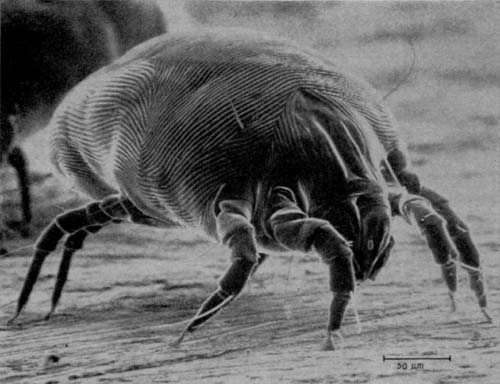
A “Mitey” Monster
The scary beast in Figure 13.5.1 is likely to be lurking in your own home, where it feeds on organic debris, including human skin. What is it? It’s the common dust mite, a close relative of spiders. The dust mite is so small that it is barely visible with the unaided eye, so it’s obviously shown greatly enlarged above. If you think you can get rid of dust mites in your home by frequent and thorough cleaning, think again. There may be thousands of dust mites in just one gram of dust! Regardless of how clean you keep your house, you can’t eliminate dust mites entirely. So why even bother trying? The feces of dust mites contain proteins that are a common trigger of asthma attacks.
Asthma
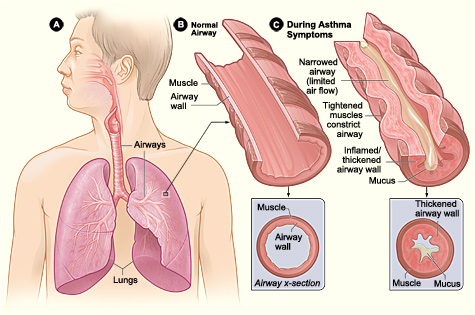
Asthma is a chronic inflammatory disease of the airways in the lungs, in which the airways periodically become inflamed. As you can see in Figure 13.5.2, this causes swelling and narrowing of the airways, often accompanied by excessive mucus production. Symptoms of asthma include difficulty breathing, coughing, wheezing, shortness of breath, and chest tightness. Some people with asthma rarely experience symptoms, and then usually only in response to certain triggers in the environment. Other people may have symptoms almost all of the time.
Asthma is thought to be caused by a combination of genetic and environmental factors. A person with a family history of asthma is more likely to develop the disease. Dozens of genes have been found to be associated with asthma, many of which are related to the immune system. Additional risk factors include obesity and sleep apnea. Environmental factors trigger asthma attacks in people who have a genetic predisposition to the disease. Besides dust mite feces, triggers may include other allergens (such as pet dander, cockroaches, and mold), certain medications including aspirin, air pollution, and stress. Symptoms tend to be worse at night and early in the morning. They may also worsen during upper respiratory tract infections, strenuous exercise, or when the airways are exposed to cold air.
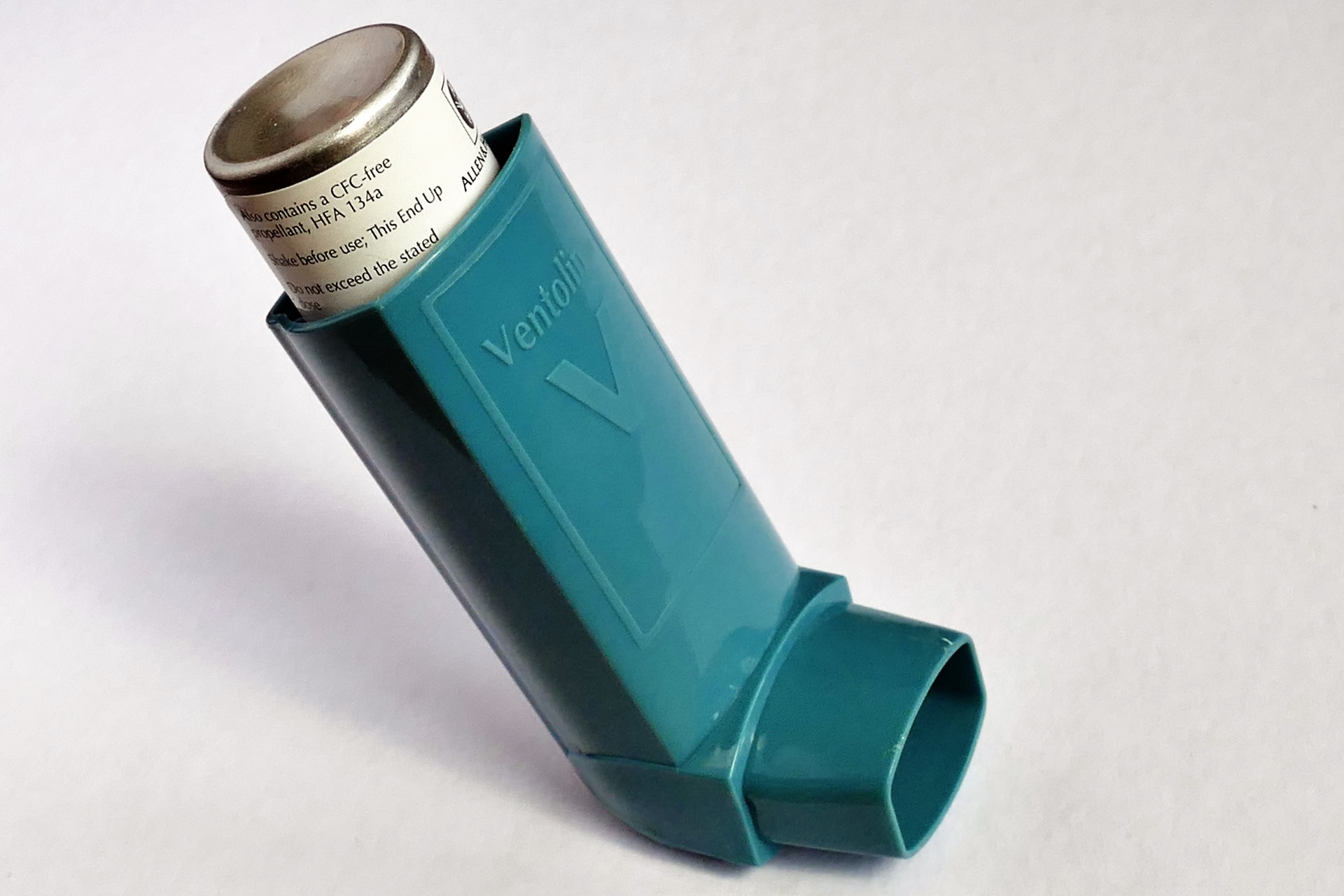
There is no cure for asthma at present, but the symptoms of asthma attacks usually can be reversed with the use of inhaled medications called bronchodilators (as shown in Figure 13.5.3). These medications soothe the constricted air passages and help to re-expand them, making breathing easier. The medications usually start to take effect almost immediately. Other medications can be taken for long-term control of the disease. These medications help prevent asthma attacks from occurring. Corticosteroids are generally considered the most effective treatment for long-term control. Another way to prevent asthma attacks is by avoiding triggers whenever possible.
Pneumonia
Another common inflammatory disease of the respiratory tract is pneumonia. In pneumonia, inflammation affects primarily the alveoli, which are the tiny air sacs of the lungs. Inflammation causes some of the alveoli to become filled with fluid so that gas exchange cannot occur, as you can see illustrated in Figure 13.5.4. Symptoms of pneumonia typically include coughing, chest pain, difficulty breathing, and fever.
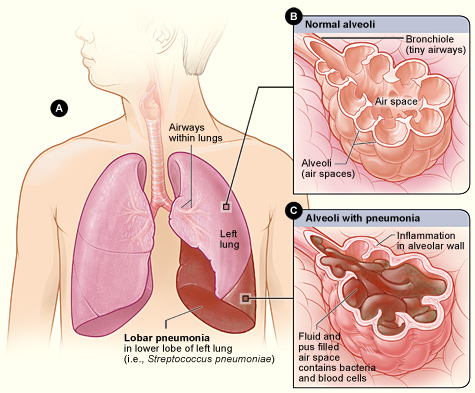
Pneumonia often develops as a consequence of an upper respiratory tract infection (such as the common cold or flu), especially in the very young and the elderly. It is usually caused by bacteria or viruses, although some cases may be caused by other microorganisms, such as fungi. The majority of cases are caused by just a few pathogens, the most common being the bacterium Streptococcus pneumoniae. Pneumonia is more likely to develop in people who have other lung diseases, such as asthma, a history of smoking, heart failure, or a weakened immune system.
Vaccines are available to prevent certain types of bacterial and viral pneumonia, including pneumonia caused by Streptococcus pneumoniae. Treatment of pneumonia depends on the cause. For example, if the disease is caused by bacteria, antibiotics are generally prescribed. In cases of severe pneumonia, hospitalization and supplemental oxygen may be required.
Chronic Obstructive Pulmonary Disease
Chronic obstructive pulmonary disease (COPD) is a lung disease characterized by chronic poor airflow due to increasing in-elasticity of lung tissue and breakdown of the walls of the alveoli. The main symptoms include shortness of breath and a cough that produces phlegm. These symptoms are usually present for a long period of time, and typically become worse over time. Eventually, walking up stairs and similar activities become difficult because of shortness of breath.
COPD formerly was referred to as chronic bronchitis or emphysema. Now, the term chronic bronchitis is used to refer to the symptoms of COPD, and the term emphysema is used to refer to the lung changes that occur with COPD. Some of these lung changes are shown in Figure 13.5.5 below. They include a breakdown of connective tissues that reduces the number and elasticity of alveoli. As a result, the patient can no longer fully exhale air from the lungs, so air becomes trapped in the lungs. Gas exchange is hampered and may lead to low oxygen levels, as well as too much carbon dioxide in the blood.
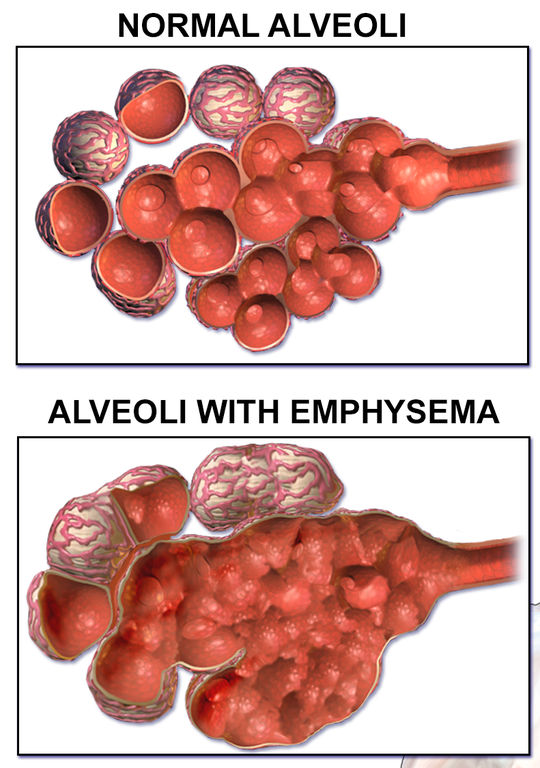
Smoking tobacco and vaping are the major cause of COPD, with a number of other factors such as air pollution and genetics playing smaller roles. Of people who are life-long smokers, about half will eventually develop COPD. Exposure to secondhand smoke in nonsmokers also increases the risk of COPD, and accounts for about 20 per cent of cases. Most cases of COPD could have been prevented by never smoking or vaping. In people who have already been diagnosed with COPD, cessation of smoking or vaping can slow down the rate at which COPD worsens. People with COPD may be treated with supplemental oxygen and inhaled bronchodilators. These treatments may reduce the symptoms, but there is no cure for COPD except — in very severe cases — lung transplantation.
Lung Cancer
Lung cancer is a malignant tumor characterized by uncontrolled cell growth in tissues of the lung. The tumor may arise directly from lung tissue (primary lung cancer), or as a result of metastasis from cancer in another part of the body (secondary lung cancer). Primary lung cancer may also metastasize and spread to other parts of the body. Lung cancer develops after genetic damage to DNA that affects the normal functions of the cell. As more damage accumulates, the risk of cancer increases. The most common symptoms of lung cancer include coughing (especially coughing up blood), wheezing, shortness of breath, chest pain, and weight loss.
The major cause of primary lung cancer is tobacco use, which accounts for about 85 per cent of cases. Cigarette smoke contains numerous cancer-causing chemicals. Besides smoking, other potential causes of lung cancer include exposure to radon gas, asbestos, secondhand smoke, or other air pollutants. When tobacco smoking is combined with another risk factor (such as exposure to radon or asbestos), the risk of lung cancer is heightened. People who have close biological relatives with lung cancer are also at increased risk of developing the disease.
Most cases of lung cancer cannot be cured. In many people, the cancer has already spread beyond the original site by the time they have symptoms and seek medical attention. About ten per cent of people with lung cancer do not have symptoms when they are diagnosed, and the cancers are found when they have a chest X-ray for another problem. In part because of its typically late diagnosis, lung cancer is the most common cause of cancer-related death in men, and the second most common cause in women (after breast cancer). Approximately 21,000 Canadians die from lung cancer each year. Common treatments for lung cancer include surgical removal of the tumor, radiation therapy, chemotherapy, or some combination of these three types of treatment.
Feature: My Human Body
Do you — or someone you love — snore? Snoring may be more than just an annoyance. It may also be a sign of a potentially dangerous and common disorder known as sleep apnea. Sleep apnea is characterized by pauses in breathing that occur most often because of physical blockage to airflow during sleep. When breathing is paused, carbon dioxide builds up in the bloodstream. The higher-than-normal level of carbon dioxide in the blood causes the respiratory centers in the brain to wake the person enough to start breathing normally. This reduces the carbon dioxide level, and the person falls back asleep. This occurs repeatedly throughout the night, causing serious disruption in sleep. Most people with sleep apnea are unaware that they have the disorder, because they don’t wake up fully enough to remember the repeated awakenings throughout the night. Instead, sleep apnea is more commonly recognized by other people who witness the episodes.
Figure 13.5.6 below shows how sleep apnea typically occurs. The muscle tone of the body normally relaxes during sleep, allowing the soft tissues in the throat to collapse and block the airway. The relaxation of muscles may be exacerbated by the use of alcohol, tranquilizers, or muscle relaxants. The risk of sleep apnea is greater in people who are overweight, smoke tobacco, or have diabetes. The disorder is also more likely to occur in older people and males. Common symptoms of sleep apnea include loud snoring, restless sleep, and daytime sleepiness and fatigue. Daytime sleepiness, in turn, increases the risk of driving and work-related accidents. Continued sleep deprivation may cause moodiness and belligerence. Lack of adequate oxygen to the body because of sleep apnea may also lead to other health problems, including fatty liver diseases and high blood pressure. Symptoms of sleep apnea may be present for years — or even decades — until (and if) a diagnosis is finally made.
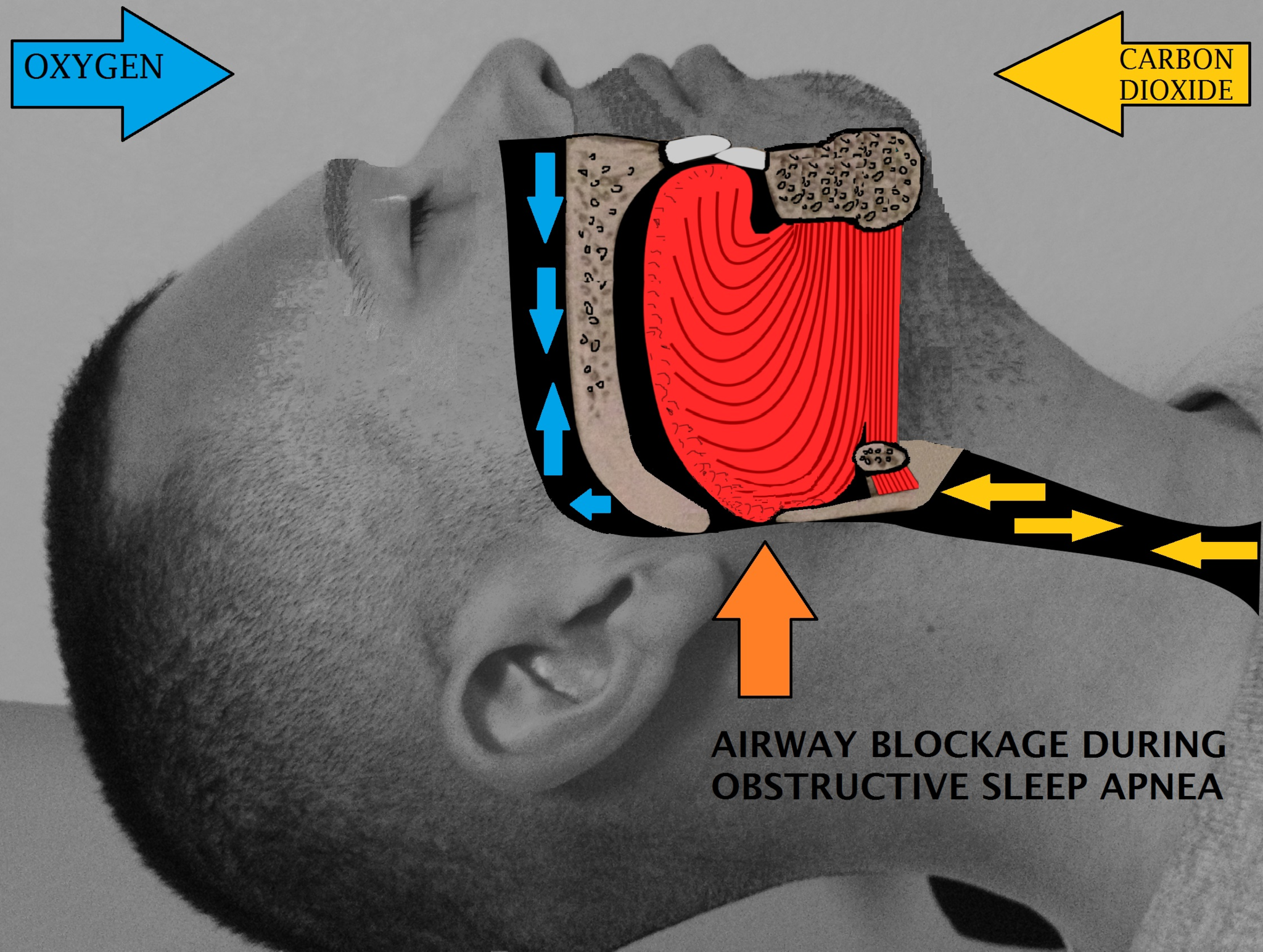
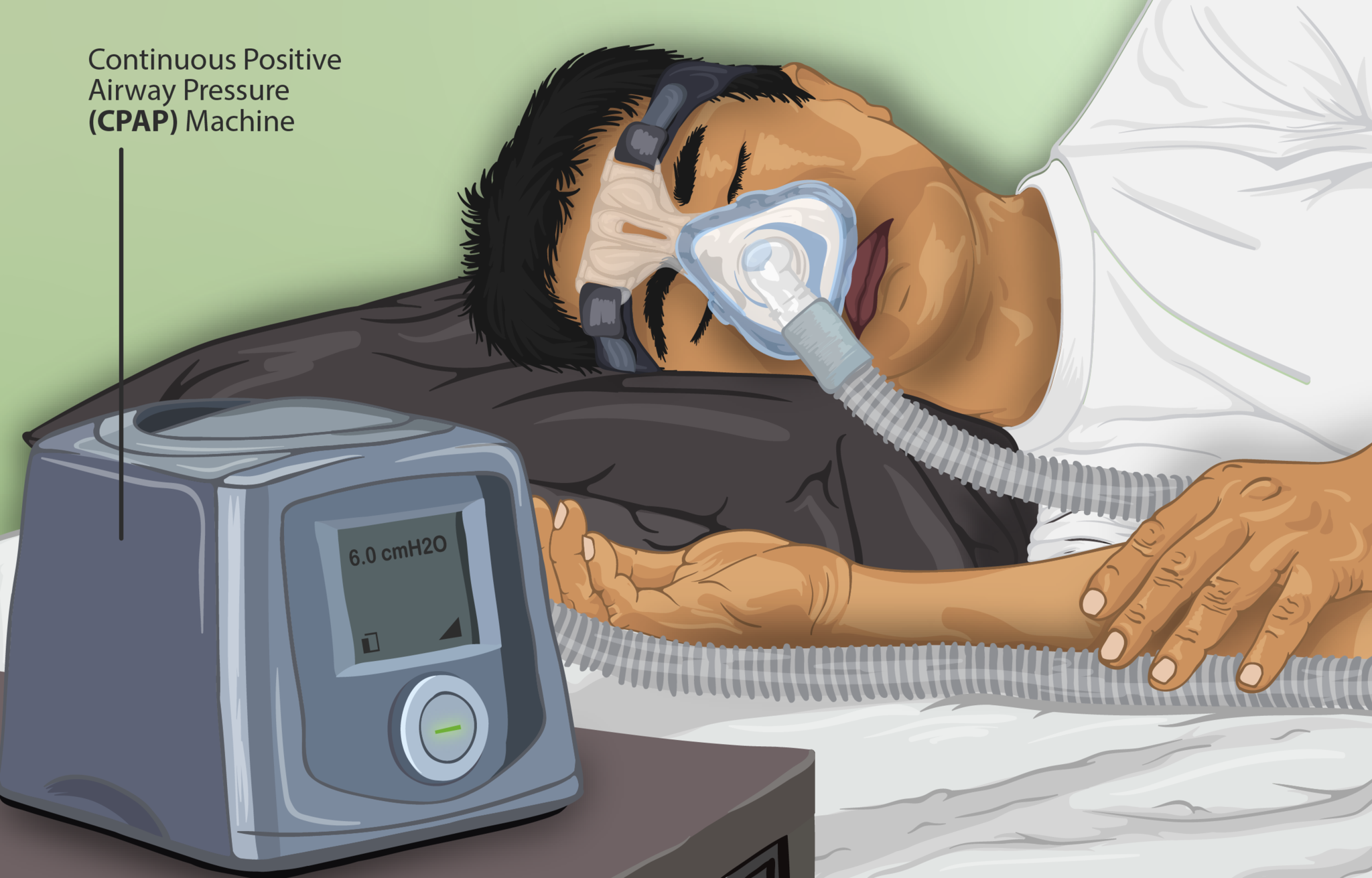
Treatment of sleep apnea may include avoiding alcohol, quitting smoking, or losing weight. Elevating the upper body during sleep or sleeping on one’s side may help prevent airway collapse in many people with sleep apnea. Another type of treatment is the use of an oral device that shifts the lower jaw forward to help keep the airway open during sleep. The most common treatment for moderate to severe sleep apnea is the use of CPAP (constant positive air pressure), which keeps the airway open by means of pressurized air during sleep. In this treatment, the person typically wears a plastic facial mask that is connected by a flexible tube to a small bedside CPAP machine as shown to the right in Figure 13.5.7. Although CPAP is effective, long-term compliance is often poor, because patients find the mask uncomfortable or they experience unpleasant side effects, such as dry mouth and nose. A more extreme form of treatment is surgery to remove some of the tissues — such as the tonsils or part of the soft palate — that tend to collapse and block the airway in people with sleep apnea.
13.5 Summary
- Asthma is a chronic inflammatory disease of the airways in the lungs, in which the airways periodically become inflamed. This causes swelling and narrowing of the airways, often with excessive mucus production, leading to difficulty breathing and other symptoms. Asthma is thought to be caused by a combination of genetic and environmental factors. Asthma attacks are triggered by allergens, air pollution, or other factors.
- Pneumonia is a common inflammatory disease of the respiratory tract, in which inflammation affects primarily the alveoli, which become filled with fluid that inhibits gas exchange. Most cases of pneumonia are caused by viral or bacterial infections. Vaccines are available to prevent pneumonia. Treatment often includes prescription antibiotics.
- Chronic obstructive pulmonary disease (COPD) is a lung disease characterized by chronic poor airflow, which causes shortness of breath and a productive cough. It is caused most often by tobacco smoking, which leads to breakdown of connective tissues in the lungs. Alveoli are reduced in number and elasticity, making it impossible to fully exhale air from the lungs. There is no cure for COPD, but stopping smoking may reduce the rate at which COPD worsens.
- Lung cancer is a malignant tumor characterized by uncontrolled cell growth in tissues of the lung. It results from accumulated DNA damage, most often caused by tobacco smoking. Lung cancer is typically diagnosed late, so most cases cannot be cured. It may be treated with surgery, chemotherapy, and/or radiation therapy.
13.5 Review Questions
-
- How can asthma attacks be prevented? How can symptoms of asthma attacks be controlled?.
- How can pneumonia be prevented? How is it treated?
- What is the difference between primary and secondary lung cancer? What is the major cause of primary lung cancer? Discuss lung cancer as a cause of death. How is lung cancer treated?
- What is the difference between how COPD and pneumonia affect the alveoli?
13.5 Explore More
Shaf Keshavjee at TEDMED 2010.
Immunology of the Lung, Nature Video, 2014.
What you should know about vaping and e-cigarettes, TEDMED, 2019.
What your breath could reveal about your health | Julian Burschka, TED, 2019.
Attributions
Figure 13.5.1
House_Dust_Mite by Employee of US Food and Drug Administration (archived) on Wikimedia Commons is in the public domain (https://en.wikipedia.org/wiki/Public_domain).
Figure 13.5.2
Asthma_attack-illustration_NIH by National Heart, Lung, Blood Institute/ U.S. National Institute of Health on Wikimedia Commons is in the public domain (https://en.wikipedia.org/wiki/Public_domain).
Figure 13.5.3
asthma-inhaler by Anthony Poynton on Public Domain Pictures is used under a CC0 1.0 Universal Public Domain Dedication License (https://creativecommons.org/publicdomain/zero/1.0/).
Figure 13.5.4
Lobar_pneumonia_illustrated by National Heart, Lung and Blood Institute / U.S. National Institute of Health on Wikimedia Commons is in the public domain (https://en.wikipedia.org/wiki/Public_domain).
Figure 13.5.5
Blausen_0343_Emphysema by Blausen Medical Communications, Inc. on Wikimedia Commons is used under a CC BY 3.0 (https://creativecommons.org/licenses/by/3.0) license.
Figure 13.5.6
Airway_obstruction by Drcamachoent on Wikimedia Commons is used under a CC BY-SA 4.0 (https://creativecommons.org/licenses/by-sa/4.0) license.
Figure 13.5.7
Depiction_of_a_Sleep_Apnea_patient_using_a_CPAP_machine by https://www.myupchar.com/en on Wikimedia Commons is used under a CC BY-SA 4.0 (https://creativecommons.org/licenses/by-sa/4.0) license.
References
Centers for Disease Control and Prevention (CDC). (2020). Travel: Pneumococcal disease (streptococcus pneumoniae) [online article]. U.S. Department of Health & Human Services. https://wwwnc.cdc.gov/travel/diseases/pneumococcal-disease-streptococcus-pneumoniae
Nature Video. (2014, December 15). Immunology of the lung. YouTube. https://www.youtube.com/watch?v=rgphaHmAC_A&feature=youtu.be
TED. (2019, February 25). What your breath could reveal about your health | Julian Burschka. YouTube. https://www.youtube.com/watch?v=aQsOmGflf1o&feature=youtu.be
TEDMED. (2010, December 7). Shaf Keshavjee at TEDMED 2010. YouTube. https://www.youtube.com/watch?v=T2EmuyHoMAI&feature=youtu.be
TEDMED. (2019, May 15). What you should know about vaping and e-cigarettes. YouTube. https://www.youtube.com/watch?v=W1rF2oFnfYI&feature=youtu.be
Image shows a bowl of kidney beans.
Created by: CK-12/Adapted by Christine Miller
The Cellulose of Our Lives
Created by: CK-12/Adapted by Christine Miller

Where would we be without our jeans? They have been the go-to pants for many people for decades, and they are still as popular as ever. Jeans are made of denim, a type of cotton fabric. Cotton is a soft, fluffy fibre that grows in a protective case around the seeds of cotton plants. The fibre is almost pure cellulose. Cellulose is the single most abundant biochemical compound found in Earth's living things, and it's one of several types of carbohydrates.
What Are Carbohydrates?
Carbohydrates are the most common class of biochemical compounds. They include sugars and starches. Carbohydrates are used to provide or store energy, among other uses. Like most biochemical compounds, carbohydrates are built of small repeating units, or monomers, which form bonds with each other to make larger molecules, called polymers. In the case of carbohydrates, the small repeating units are known as monosaccharides. Each monosaccharide consists of six carbon atoms, as shown in the model of the monosaccharide glucose shown in Figure 3.4.2.
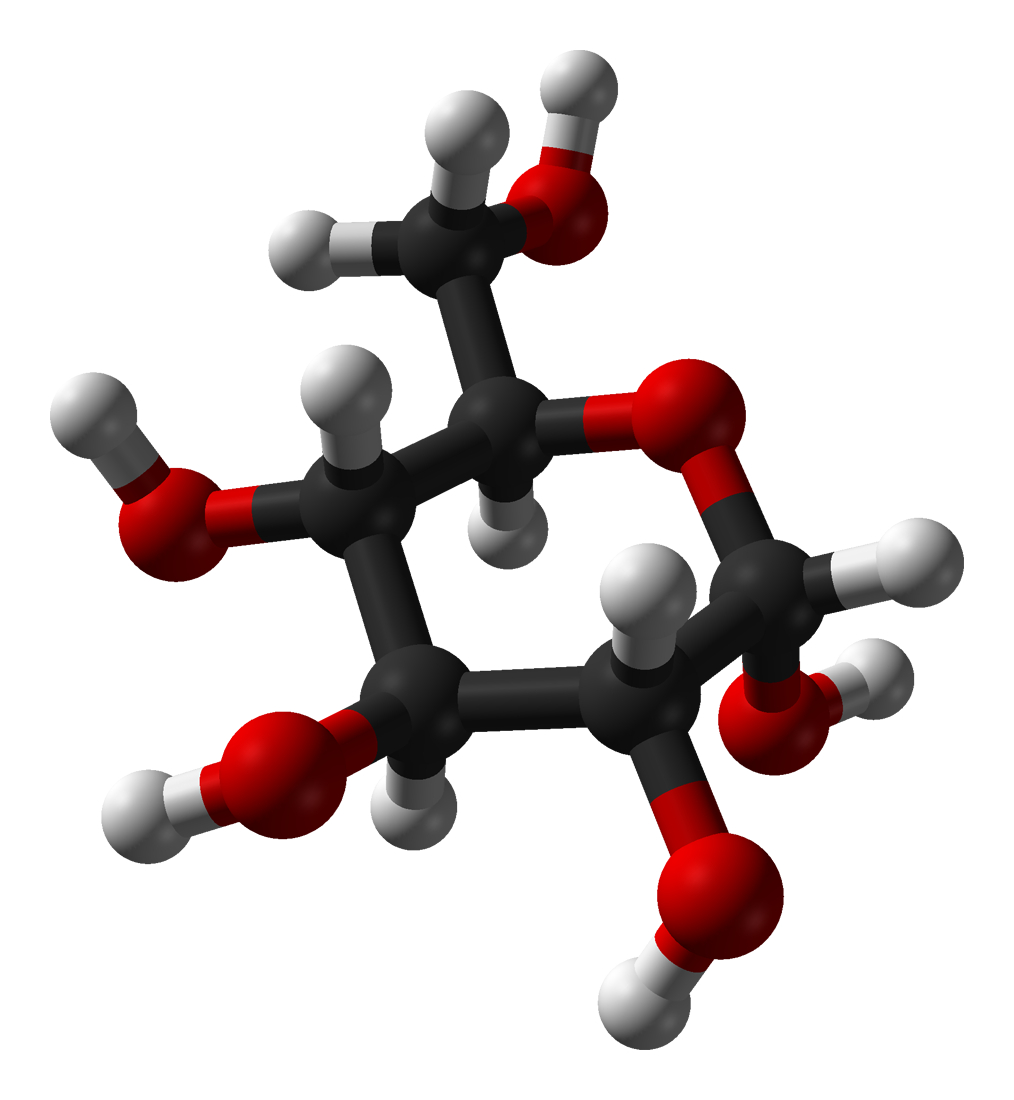
Sugars
Sugars are the general name for sweet, short-chain, soluble carbohydrates, which are found in many foods. Their function in living things is to provide energy. The simplest sugars consist of a single monosaccharide. They include glucose, fructose, and galactose. Glucose is a simple sugar that is used for energy by the cells of living things. Fructose is a simple sugar found in fruits, and galactose is a simple sugar found in milk. Their chemical structures are shown in Figure 3.4.3. All monosaccharides have the formula C6H12O6.
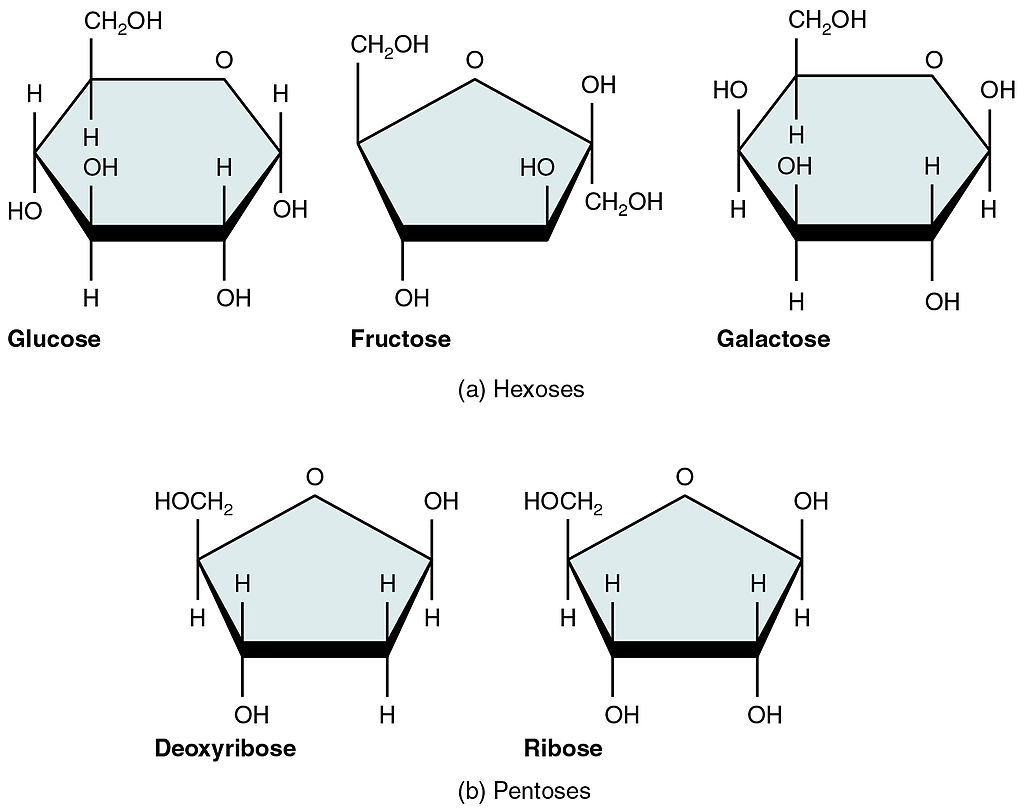
Other sugars contain two monosaccharide molecules and are called disaccharides. These include sucrose (table sugar), maltose, and lactose. Sucrose is composed of one fructose molecule and one glucose molecule, maltose is composed of two glucose molecules, and lactose is composed of one glucose molecule and one galactose molecule. Lactose occurs naturally in milk. Some people are lactose intolerant because they can't digest lactose. If they drink milk, it causes gas, cramps, and other unpleasant symptoms, unless the milk has been processed to remove the lactose.
Complex Carbohydrates
Some carbohydrates consist of hundreds — or even thousands! — of monosaccharides bonded together in long chains. These carbohydrates are called polysaccharides ("many saccharides"). Polysaccharides are also referred to as complex carbohydrates. Complex carbohydrates that are found in living things include starch, glycogen, cellulose, and chitin. Each type of complex carbohydrate has different functions in living organisms, but they generally either store energy or make up certain structures in living things.
Starch
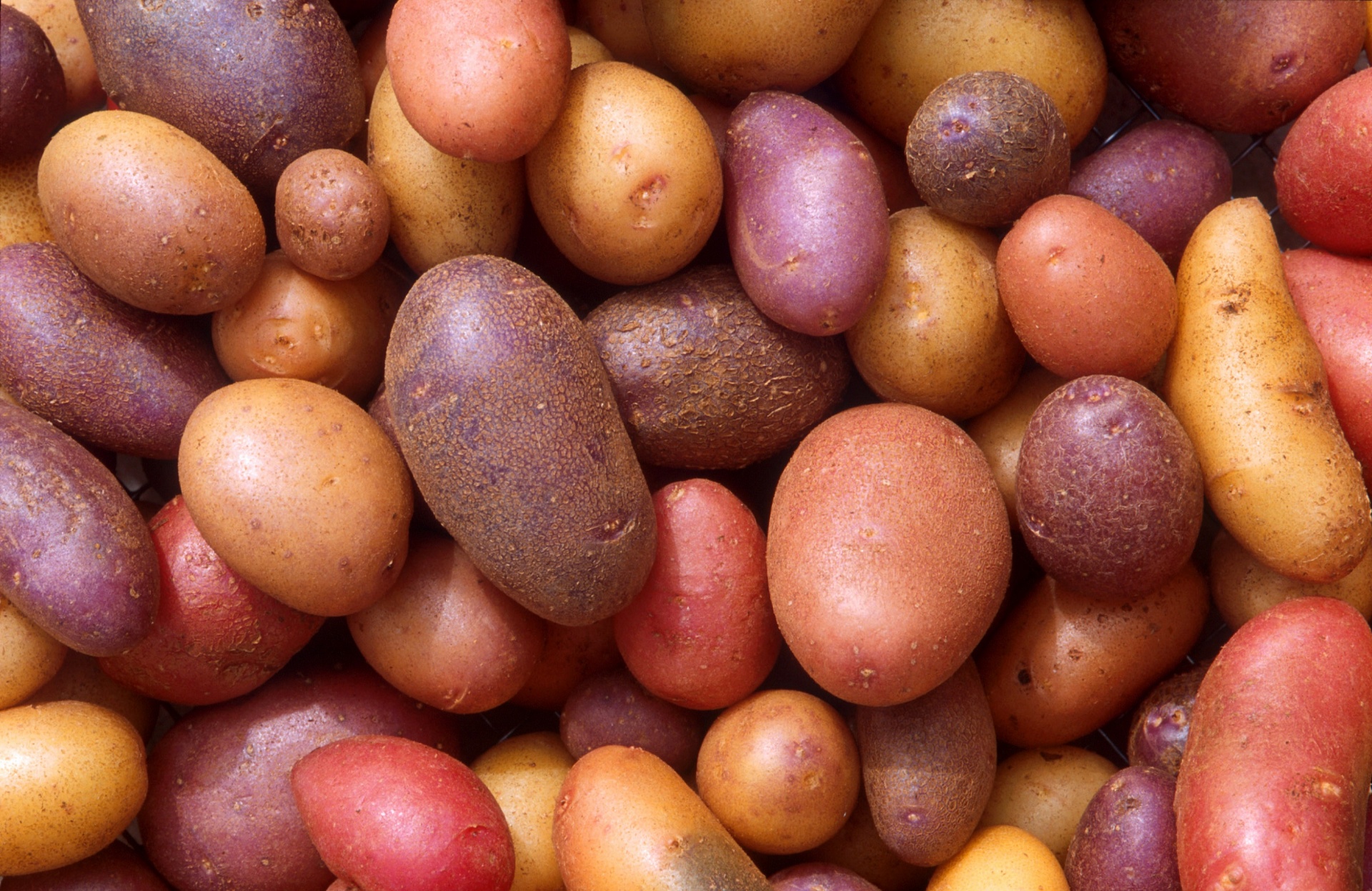
Starch is a complex carbohydrate that is made by plants to store energy. For example, the potatoes pictured in Figure 3.4.4 are packed full of starches that consist mainly of repeating units of glucose and other simple sugars. The leaves of potato plants make sugars by photosynthesis, and the sugars are carried to underground tubers where they are stored as starch. When we eat starchy foods such as potatoes, the starches are broken down by our digestive system into sugars, which provide our cells with energy. Starches are easily and quickly digested with the help of digestive enzymes such as amylase, which is found in the saliva. If you chew a starchy saltine cracker for several minutes, you may start to taste the sugars released as the starch is digested.
Glycogen
Animals do not store energy as starch. Instead, animals store extra energy as the complex carbohydrate glycogen. Glycogen is a polysaccharide of glucose. It serves as a form of energy storage in fungi (as well as animals), and it is the main storage form of glucose in the human body. In humans, glycogen is made and stored primarily in the cells of the liver and muscles. When energy is needed from either storage area, the glycogen is broken down to glucose for use by cells. Muscle glycogen is converted to glucose for use by muscle cells, and liver glycogen is converted to glucose for use throughout the rest of the body. Glycogen forms an energy reserve that can be quickly mobilized to meet a sudden need for glucose, but one that is less compact than the energy reserves of lipids, which are the primary form of energy storage in animals.
Glycogen plays a critical part in the homeostasis of glucose levels in the blood. When blood glucose levels rise too high, excess glucose can be stored in the liver by converting it to glycogen. When glucose levels in the blood fall too low, glycogen in the liver can be broken down to glucose and released into the blood.
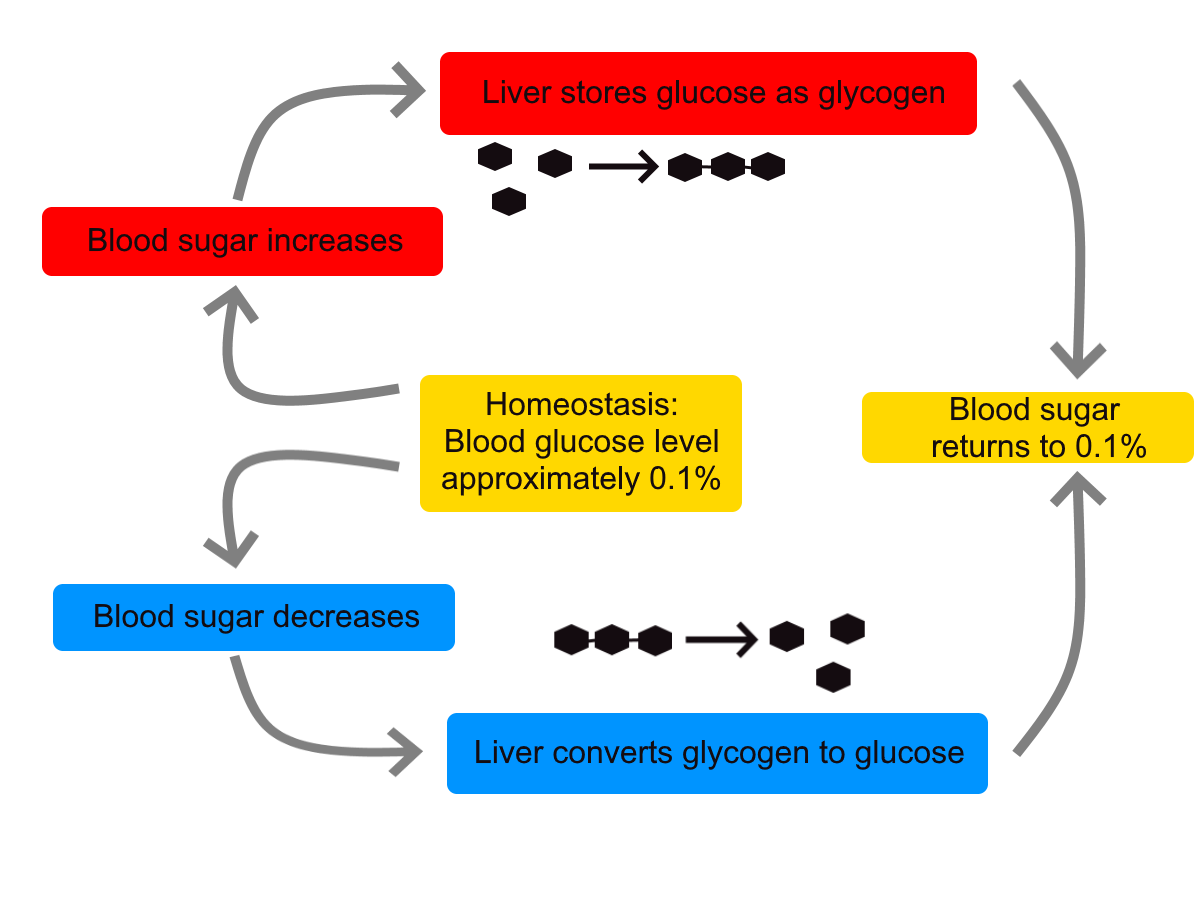
Cellulose

Cellulose is a polysaccharide consisting of a linear chain of several hundred to many thousands of linked glucose units. Cellulose is an important structural component of the cell walls of plants and many algae. Human uses of cellulose include the production of cardboard and paper, which consist mostly of cellulose from wood and cotton. The cotton fibres pictured are about 90 per cent cellulose.
Certain animals, including termites and ruminants such as cows, can digest cellulose with the help of microorganisms that live in their gut. Humans cannot digest cellulose, but it nonetheless plays an important role in our diet. It acts as a water-attracting bulking agent for feces in the digestive tract and is often referred to as "dietary fibre." In simpler terms, it helps you poop.
Chitin
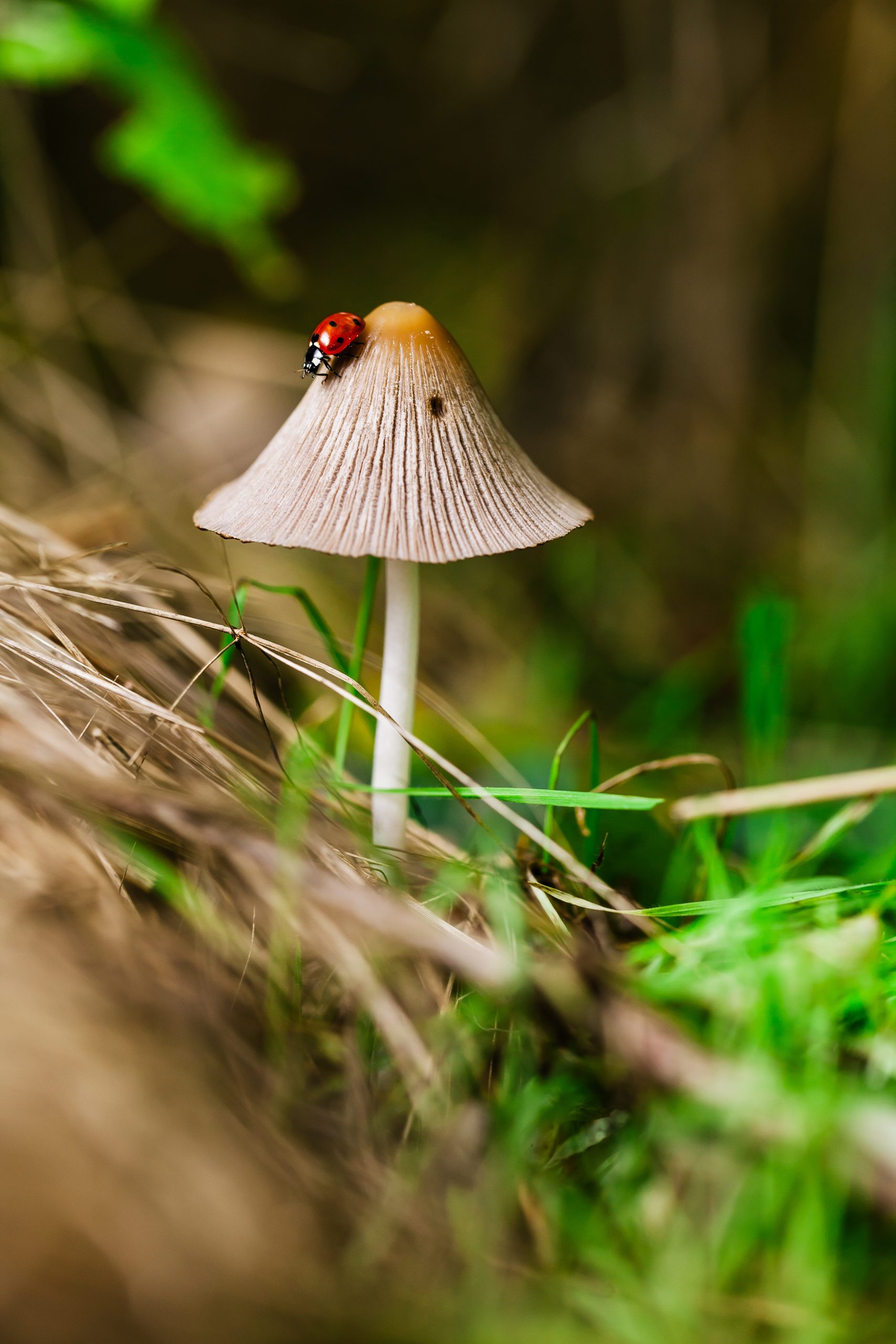
Chitin is a long-chain polymer of a derivative of glucose. It is found in many living things. For example, it is a component of the cell walls of fungi; the exoskeletons of arthropods, such as crustaceans and insects ; and the beaks and internal shells of animals, such as squids and octopuses. The structure of chitin is similar to that of cellulose.
In Figure 3.4.7, both the exoskeleton of the ladybug and the cell walls of the mushroom are made partly of the complex carbohydrate chitin.
The Right Molecule for the Job
Starch, glycogen, cellulose and chitin are all made from the monomer glucose. So how are they all so different? Their difference in structure and function is related to how they are linked together. Starch is linked in long chains with a small amount of branching, glycogen is linked in many branching chains, and chitin and cellulose form long single chains that pack together tightly. Each of these variations of linking the same monomer, glucose, together creates a different way the molecule can be used. As shown in the Figure 3.4.8 diagram, starch and glycogen have many exposed "ends" of their chains. These are areas where a glucose molecule can easily be removed for use as energy, whereas cellulose does not. For this reason, glycogen and starch are well-suited for energy storage in organisms while cellulose is not. Conversely, cellulose packs many monomers together in a sort of mesh that is very strong — this is why it is a great option for building strong cell walls.

Feature: My Human Biology
You probably know that you should eat plenty of fibre, but do you know how much fibre you need, how fibre contributes to good health, or which foods are good sources of fibre? Dietary fibre consists mainly of cellulose, so it is found primarily in plant-based foods, including fruits, vegetables, whole grains, and legumes. Dietary fibre can't be broken down and absorbed by your digestive system. Instead, it passes relatively unchanged through your gastrointestinal tract and is excreted in feces (otherwise known as poop). That's how it helps keep you healthy.
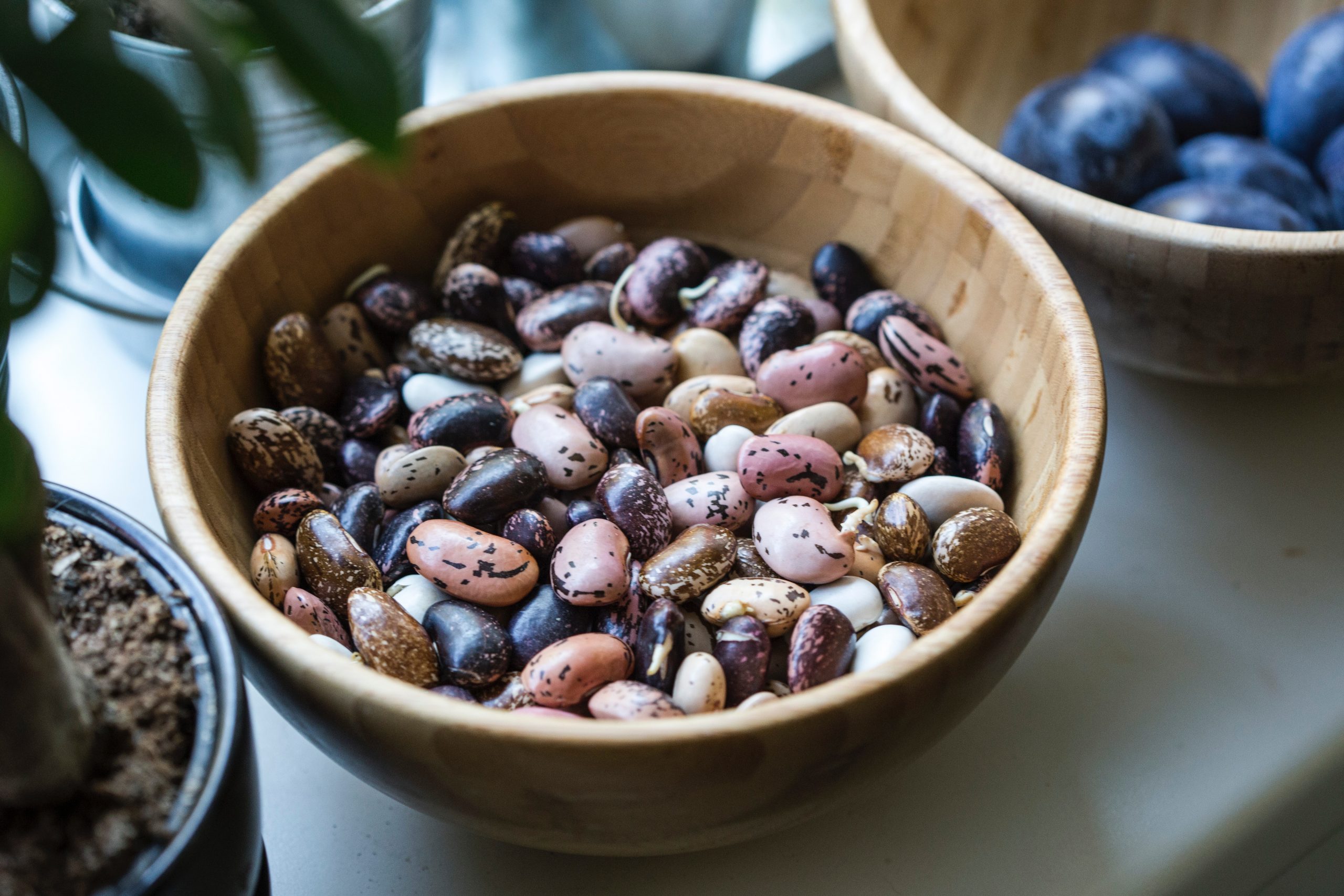
Fibre in food is commonly classified as either soluble or insoluble fibre.
- Soluble fibre dissolves in water to form a gel-like substance as it passes through the gastrointestinal tract. It lowers blood levels of cholesterol and glucose, which is beneficial for your health. Good sources of soluble fibre include whole oats, peas, beans, and apples.
- Insoluble fibre does not dissolve in water. This type of fibre increases the bulk of feces in the large intestine, and helps keep food wastes moving through, which may help prevent or correct constipation. Good sources of insoluble fibre include whole wheat, wheat bran, beans, and potatoes.
How much fibre do you need for good health? That depends on your age and gender. The Institute of Medicine recommends the daily fibre intake for adults shown in Table 3.4.1 below. Most dietitians further recommend a ratio of about three parts of insoluble fibre to one part of soluble fibre each day. Most fibre-rich foods contain both types of fibre, so it usually isn't necessary to keep track of the two types of fibre as long as your overall fibre intake is adequate.
Table 3.4.1
Recommended Daily Fibre Intake for Males and Females
| Recommended Daily Fibre Intake for Males and Females | ||
| Gender | Age 50 or Younger | Age 51 or Older |
| Male | 38 grams | 30 grams |
| Female | 25 grams | 21 grams |
Use food labels like the one shown below in Figure 3.4.10 and online fibre counters to find out how much total fibre you eat in a typical day. Are you consuming enough fibre for good health? If not, consider ways to increase your intake of this important substance. For example, substitute whole grains for refined grains, eat more legumes (such as beans), and try to consume at least five servings of fruits and vegetables each day.

Table 3.4.2
Carbohydrate Comparison
Name |
Class |
Function |
Location |
| Glucose | Monosaccharide | Energy for cells | Cells |
| Starch | Polysaccharide | Energy storage | Plant cells |
| Glycogen | Polysaccharide | Energy storage | Animal cells |
| Cellulose | Polysaccharide | Structural component in cell walls | Plant cells |
| Chitin | Polysaccharide | Structural component in cell walls and exoskeletons | Fungi and arthropods |
3.4 Summary
- Carbohydrates are the most common class of biochemical compounds. The basic building block of carbohydrates is the monosaccharide, which consists of six carbon atoms.
- Sugars are sweet, short-chain, soluble carbohydrates that are found in many foods and supply us with energy. Simple sugars, such as glucose, consist of just one monosaccharide. Some sugars, such as sucrose (or table sugar), consist of two monosaccharides. These are called disaccharides.
- Complex carbohydrates, or polysaccharides, consist of hundreds — or even thousands — of monosaccharides. They include starch, glycogen, cellulose, and chitin. They generally either store energy or form structures, such as cell walls, in living things.
- Starch is a complex carbohydrate that is made by plants to store energy. Potatoes are a good food source of dietary starch, which is readily broken down into its component sugars during digestion.
- Glycogen is a complex carbohydrate that is made by animals and fungi to store energy. Glycogen plays a critical part in the homeostasis of blood glucose levels in humans.
- Cellulose is the single most common biochemical compound in living things. It forms the cell walls of plants and certain algae. Like most other animals, humans cannot digest cellulose, but it makes up most of the crucial dietary fibre in the human diet.
- Chitin is a complex carbohydrate, similar to cellulose, that makes up organic structures, such as the cell walls of fungi and the exoskeletons of insects and other arthropods.
3.4 Review Questions
- What are carbohydrates? Describe their structure.
- Compare and contrast sugars and complex carbohydrates.
-
- If you chew on a starchy food (such as a saltine cracker) for several minutes, it may start to taste sweet. Explain why.
- True or False: Glucose is mainly stored by lipids in the human body.
-
- Name three carbohydrates that contain glucose as a monomer.
- Jeans are made of tough, durable cotton. Based on what you know about the structure of carbohydrates, explain how you think this fabric gets its tough qualities.
- Which do you think is faster to digest — simple sugars or complex carbohydrates? Explain your answer.
- True or False: Cellulose is broken down in the human digestive system into glucose molecules.
- ___________ fibre dissolves in water, __________ fibre does not dissolve in water.
- What are the similarities and differences between muscle glycogen and liver glycogen?
- Which carbohydrate is used directly by the cells of living things for energy?
- Which of the following is not a complex carbohydrate?
- Chitin
- Starch
- Disaccharide
- None of the above
3.4 Explore More
https://youtu.be/wxzc_2c6GMg
How do carbohydrates impact your health? - Richard J. Wood, TED-Ed, 2016
https://www.youtube.com/watch?v=tKLJ6KQAcjI
Why is cotton in everything? - Michael R. Stiff, TED-Ed, 2020
Attributions
Figure 3.4.1
Jeans by Maude Frédérique Lavoie on Unsplash is used under the Unsplash License (https://unsplash.com/license).
Figure 3.4.2
e-from-xtal-1979-Alpha-D-glucose-from-xtal-1979-3D-balls by Ben Mills [Benjah-bmm27] on Wikimedia Commons, is released into the public domain (https://en.wikipedia.org/wiki/Public_domain).
Figure 3.4.3
Monosasccharides by OpenStax College on Wikimedia Commons is used under a CC BY 4.0 (https://creativecommons.org/licenses/by/4.0) license.
Figure 3.4.4
Potatoes by Jean Beaufort, on Public Domain Pictures.net, is used under a CC0 1.0 Universal Public Domain Dedication license (https://creativecommons.org/publicdomain/zero/1.0/).
Figure 3.4.5
Homeostasis_of_blood_sugar by Christine Miller [christinelmiller] Is used under a CC0 1.0 Universal Public Domain Dedication license (https://creativecommons.org/publicdomain/zero/1.0/).
Figure 3.4.6
Cotton by David Nance for Agricultural Research Service, the research agency of the United States Department of Agriculture, on Wikimedia Commons, is released into the public domain (https://en.wikipedia.org/wiki/Public_domain).
Figure 3.4.7
Ladybug on a mushroom /Fungi in the Woods by Benjamin Balázs on Unsplash is used under the Unsplash License (https://unsplash.com/license).
Figure 3.4.8
Carbohydrate structure comparison [Three Important Polysaccharides] by OpenStax College is on Wikimedia Commons, used under a CC BY 3.0 (https://creativecommons.org/licenses/by/3.0) license.
Figure 3.4.9
Beans by Milada Vigerova on Unsplash is used under the Unsplash License (https://unsplash.com/license).
Figure 3.4.10
FDA Nutrition Facts Label 2014, by US Food and Drug Administration, on Wikimedia Commons is released into the public domain (https://en.wikipedia.org/wiki/Public_domain).
Table 3.4.1
Recommended Daily Fibre Intake for Males and Females is from OpenStax, used under a CC BY 4.0 (https://creativecommons.org/licenses/by/4.0) license..
Table 3.4.2
Carbohydrate Comparison is from OpenStax. used under a CC BY 4.0 (https://creativecommons.org/licenses/by/4.0) license.
References
Betts, J.G., Young, K.A., Wise, J.A., Johnson, E., Poe, B., Kruse, D.H., Korol, O., Johnson, J.E., Womble, M., DeSaix, P. (2013, April 25). Figure 2.18. Five important monosaccharides [image]. In Anatomy and Physiology. OpenStax. https://openstax.org/books/anatomy-and-physiology/pages/1-introduction
Betts, J.G., Young, K.A., Wise, J.A., Johnson, E., Poe, B., Kruse, D.H., Korol, O., Johnson, J.E., Womble, M., DeSaix, P. (2013, April 25). Figure 2.20. Three important polysaccharides [image]. In Anatomy and Physiology. OpenStax. https://openstax.org/books/anatomy-and-physiology/pages/1-introduction
Mayo Clinic. (n.d.). Lactose intolerance [online article]. Mayo Foundation for Medical Education and Research (MFMER). https://www.mayoclinic.org/diseases-conditions/lactose-intolerance/symptoms-causes/syc-20374232
TED-Ed. (2016, January 11). How do carbohydrates impact your health? - Richard J. Wood. YouTube. https://youtu.be/wxzc_2c6GMg
TED-Ed. (2020, January 23). Why is cotton in everything? - Michael R. Stiff. https://www.youtube.com/watch?v=tKLJ6KQAcjI
Created by CK-12 Foundation/Adapted by Christine Miller

Case Study: Flight Risk
Nineteen-year-old Malcolm is about to take his first plane flight. Shortly after he boards the plane and sits down, a man in his late sixties sits next to him in the aisle seat. About half an hour after the plane takes off, the pilot announces that she is turning the seat belt light off, and that it is safe to move around the cabin.
The man in the aisle seat — who has introduced himself to Malcolm as Willie — immediately unbuckles his seat belt and paces up and down the aisle a few times before returning to his seat. After about 45 minutes, Willie gets up again, walks some more, then sits back down and does some foot and leg exercises. After the third time Willie gets up and paces the aisles, Malcolm asks him whether he is walking so much to accumulate steps on a pedometer or fitness tracking device. Willie laughs and says no. He is actually trying to do something even more important for his health — prevent a blood clot from forming in his legs.
Willie explains that he has a chronic condition: heart failure. Although it sounds scary, his condition is currently well-managed, and he is able to lead a relatively normal lifestyle. However, it does put him at risk of developing other serious health conditions, such as deep vein thrombosis (DVT), which is when a blood clot occurs in the deep veins, usually in the legs. Air travel — and other situations where a person has to sit for a long period of time — increases the risk of DVT. Willie’s doctor said that he is healthy enough to fly, but that he should walk frequently and do leg exercises to help avoid a blood clot.
As you read this chapter, you will learn about the heart, blood vessels, and blood that make up the cardiovascular system, as well as disorders of the cardiovascular system, such as heart failure. At the end of the chapter you will learn more about why DVT occurs, why Willie has to take extra precautions when he flies, and what can be done to lower the risk of DVT and its potentially deadly consequences.
Chapter Overview: Cardiovascular System
In this chapter, you will learn about the cardiovascular system, which transports substances throughout the body. Specifically, you will learn about:
- The major components of the cardiovascular system: the heart, blood vessels, and blood.
- The functions of the cardiovascular system, including transporting needed substances (such as oxygen and nutrients) to the cells of the body, and picking up waste products.
- How blood is oxygenated through the pulmonary circulation, which transports blood between the heart and lungs.
- How blood is circulated throughout the body through the systemic circulation.
- The components of blood — including plasma, red blood cells, white blood cells, and platelets — and their specific functions.
- Types of blood vessels — including arteries, veins, and capillaries — and their functions, similarities, and differences.
- The structure of the heart, how it pumps blood, and how contractions of the heart are controlled.
- What blood pressure is and how it is regulated.
- Blood disorders, including anemia, HIV, and leukemia.
- Cardiovascular diseases (including heart attack, stroke, and angina), and the risk factors and precursors — such as high blood pressure and atherosclerosis — that contribute to them.
As you read the chapter, think about the following questions:
- What is heart failure?Why do you think it increases the risk of DVT?
- What is a blood clot? What are possible health consequences of blood clots?
- Why do you think sitting for long periods of time increases the risk of DVT? Why does walking and exercising the legs help reduce this risk?
Attribution
Figure 14.1.1
aircraft-1583871_1920 [photo] by olivier89 from Pixabay is used under the Pixabay License (https://pixabay.com/de/service/license/).
Diagram shows examples of the shapes of different types of fatty acids. Saturated fatty acids form long straight chains. Monounsaturated fatty acids have a slight curve and saturated fatty acids can have multiple curves or bends.
A genetic mutation caused by a deletion or insertion in a DNA sequence that shifts the way the sequence is read.

